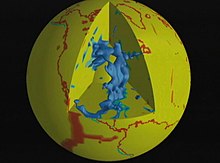

In geology, the slab is a significant constituent of subduction zones.[1]
Subduction slabs drive plate tectonics by pulling along the lithosphere to which they attach in a process known as slab pull and by inducing currents in the mantle via slab suction.[2] The slab affects the convection and evolution of the Earth's mantle due to the insertion of the hydrous oceanic lithosphere.[3] Dense oceanic lithosphere retreats into the Earth's mantle, while lightweight continental lithospheric material produces active continental margins and volcanic arcs, generating volcanism.[4] Recycling the subducted slab presents volcanism by flux melting from the mantle wedge.[5] The slab motion can cause dynamic uplift and subsidence of the Earth's surface, forming shallow seaways[2] and potentially rearranging drainage patterns.[6]
Geologic features of the subsurface can infer subducted slabs by seismic imaging.[7][8] Subduction slabs are dynamic; slab characteristics such as slab temperature evolution, flat-slab, deep-slab, and slab detachment can be expressed globally near subduction zones.[9] Temperature gradients of subducted slabs depend on the oceanic plate's time and thermal structures.[10] Slabs experiencing low angle (less than 30 degrees) subduction is considered flat-slab, primarily in southern China and the western United States.[11][12] Marianas Trench is an example of a deep slab, thereby creating the deepest trench in the world established by a steep slab angle.[13] Slab breakoff occurs during a collision between oceanic and continental lithosphere,[14] allowing for a slab tear; an example of slab breakoff occurs within the Himalayan subduction zone.[4]
See also[edit]
- Slab window – Type of gap in a subducted oceanic plate
References[edit]
- ^ Conrad, C. P. "How Mantle Slabs Drive Plate Motions". Archived from the original on June 13, 2011. Retrieved 24 April 2011.
- ^ a b Mitrovica, J. X.; Beaumont, C.; Jarvis, G. T. (1989). "Tilting of continental interiors by the dynamical effects of subduction". Tectonics. 8 (5): 1079. Bibcode:1989Tecto...8.1079M. doi:10.1029/TC008i005p01079.
- ^ Wada, Ikuko; Behn, Mark D.; Shaw, Alison M. (2012-11-01). "Effects of heterogeneous hydration in the incoming plate, slab rehydration, and mantle wedge hydration on slab-derived H2O flux in subduction zones". Earth and Planetary Science Letters. 353–354: 60–71. Bibcode:2012E&PSL.353...60W. doi:10.1016/j.epsl.2012.07.025. ISSN 0012-821X.
- ^ a b Frisch, Wolfgang; Meschede, Martin; Blakey, Ronald (2011), "Subduction zones, island arcs and active continental margins", Plate Tectonics, Berlin, Heidelberg: Springer Berlin Heidelberg, pp. 91–122, doi:10.1007/978-3-540-76504-2_7, ISBN 978-3-540-76503-5, retrieved 2021-12-10
- ^ Iwamori, Hikaru (1998-07-01). "Transportation of H2O and melting in subduction zones". Earth and Planetary Science Letters. 160 (1): 65–80. Bibcode:1998E&PSL.160...65I. doi:10.1016/S0012-821X(98)00080-6. ISSN 0012-821X.
- ^ Shephard, G. E.; Müller, R. D.; Liu, L.; Gurnis, M. (2010). "Miocene drainage reversal of the Amazon River driven by plate–mantle interaction". Nature Geoscience. 3 (12): 870–75. Bibcode:2010NatGe...3..870S. CiteSeerX 10.1.1.653.4596. doi:10.1038/ngeo1017.
- ^ Rondenay, Stéphane; Abers, Geoffrey A.; van Keken, Peter E. (2008). "Seismic imaging of subduction zone metamorphism". Geology. 36 (4): 275. Bibcode:2008Geo....36..275R. doi:10.1130/G24112A.1. ISSN 0091-7613.
- ^ Zhao, Dapeng; Ohtani, Eiji (2009-12-01). "Deep slab subduction and dehydration and their geodynamic consequences: Evidence from seismology and mineral physics". Gondwana Research. 16 (3): 401–413. Bibcode:2009GondR..16..401Z. doi:10.1016/j.gr.2009.01.005. ISSN 1342-937X.
- ^ Hu, Jiashun; Gurnis, Michael (April 2020). "Subduction Duration and Slab Dip". Geochemistry, Geophysics, Geosystems. 21 (4). Bibcode:2020GGG....2108862H. doi:10.1029/2019GC008862. ISSN 1525-2027. S2CID 216305697.
- ^ Holt, A. F.; Condit, C. B. (June 2021). "Slab Temperature Evolution Over the Lifetime of a Subduction Zone". Geochemistry, Geophysics, Geosystems. 22 (6). Bibcode:2021GGG....2209476H. doi:10.1029/2020GC009476. ISSN 1525-2027. S2CID 232378621.
- ^ Schellart, Wouter Pieter (2020). "Control of Subduction Zone Age and Size on Flat Slab Subduction". Frontiers in Earth Science. 8: 26. Bibcode:2020FrEaS...8...26S. doi:10.3389/feart.2020.00026. ISSN 2296-6463.
- ^ Liu, Xiaowen; Currie, Claire A. (2019). "Influence of Upper Plate Structure on Flat-Slab Depth: Numerical Modeling of Subduction Dynamics". Journal of Geophysical Research: Solid Earth. 124 (12): 13150–13167. Bibcode:2019JGRB..12413150L. doi:10.1029/2019JB018653. ISSN 2169-9356. S2CID 210254422.
- ^ Gvirtzman, Zohar; Stern, Robert J. (April 2004). "Bathymetry of Mariana trench-arc system and formation of the Challenger Deep as a consequence of weak plate coupling". Tectonics. 23 (2): n/a. Bibcode:2004Tecto..23.2011G. doi:10.1029/2003tc001581. ISSN 0278-7407. S2CID 21354196.
- ^ Huw Davies, J.; von Blanckenburg, Friedhelm (1995-01-01). "Slab breakoff: A model of lithosphere detachment and its test in the magmatism and deformation of collisional orogens". Earth and Planetary Science Letters. 129 (1): 85–102. Bibcode:1995E&PSL.129...85D. doi:10.1016/0012-821X(94)00237-S. ISSN 0012-821X.
Well, that’s interesting to know that Psilotum nudum are known as whisk ferns. Psilotum nudum is the commoner species of the two. While the P. flaccidum is a rare species and is found in the tropical islands. Both the species are usually epiphytic in habit and grow upon tree ferns. These species may also be terrestrial and grow in humus or in the crevices of the rocks.
View the detailed Guide of Psilotum nudum: Detailed Study Of Psilotum Nudum (Whisk Fern), Classification, Anatomy, Reproduction